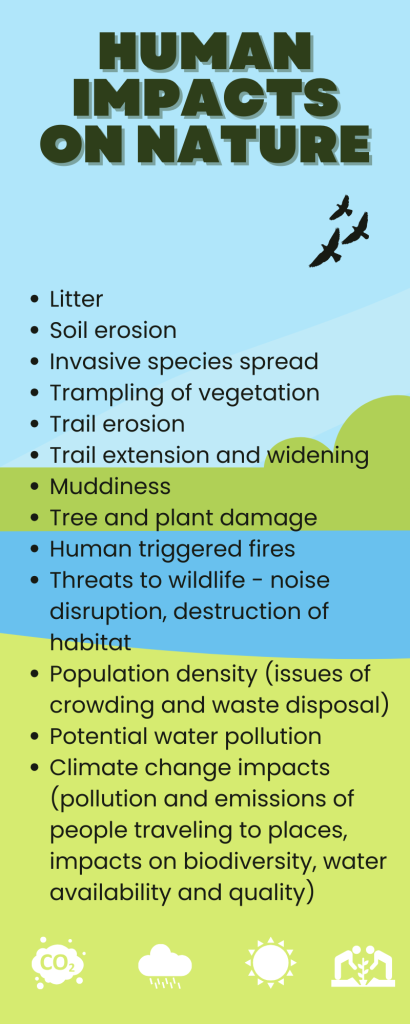The Importance of Environmental Leadership
Introduction
As professionals, educators, or guides in the outdoors, people look to us as leaders, not only for route-finding, practical skills, and safety, but for ethos, deep understanding of the environment, and as a route to building relationships with the spaces they are inhabiting.
Between 1981 and 1996, more than 80% of Canadians 15 years of age and older engaged in one or more nature-related activities.[1] In 2016 as part of the General Social Survey (Canadians at Work and Home), a survey into ‘Canadians and the Outdoors’ showed that nearly 7 in 10 Canadians participated in outdoor, nature, or wilderness activities, some in more than one (18% participated in one, 15% in two, and 41% in three or more kinds of activities).[2]
While 25 million people visit Canada’s national parks, national historic sites, and national marine conservation areas each year, and others connect with nature by visiting green spaces in their communities or by participating in nature-based activities like hiking or horseback riding,[3] increased use of electronic screen technology has shown to be associated with lower perceived importance of connections to nature. Barriers to connecting with nature include choices that young people are making, the addictive properties of technology, and beliefs that being indoors is more comfortable and safer than being outdoors.[4]
Spending time in nature and outdoors can improve physical and mental health for people of all ages and support children’s development, and spending time in relationship with and having knowledge of our natural environment is the foundation for developing abd practicing environmental responsibility and stewardship.
However, the reality is that the more people spend time in nature, the greater pressure there is on landscapes, as summarized in the below infographic.
Journaling Prompt
- How many of the impacts in the human-impacts list have you witnessed yourself in your recreation or work?
- What is one example from a place you visit frequently?
- Which of these impacts do you think will be most relevant in your sphere going forward?
Modelling Environmental Leadership

“The things we have to learn before we can do them, we learn by doing them… we become just by doing just acts, brave by doing brave acts.”
– Aristotle

It is imperative that when we are recreating, educating, or guiding in the outdoors, we model Environmental and Climate leadership as we want to be in, share in, and educate about the natural world.
If we want to balance knowledge, relationship, and connection to nature with mitigating the impacts of our presence there — in often sensitive ecological environments — then demonstrating environmental leadership in your role is a key way to do so.
If you are a person working in the outdoor sector, it is likely that you have a personal connection to the environment in some existing way. While you might not have a degree in climate (perhaps you do!), you recognize the validity or have experienced the effects of climate change and anthropogenic (human-created) environmental degradation. It is unfortunately not always the case that people coming to spend time with you in nature will have made this connection.
As you practise and model environmental leadership, even if your guests/clients/students do not immediately respond, or better still if they are wonderfully receptive, you are setting the seed and building your own habits of centreing environmentalism at the heart of your work. This effort and knowledge lays the foundation for real systemic change in the industries that access nature frequently for work (and play).
Research into the effects of training in the outdoor and tourism industry recognizes the decreasing relevance of professionals’ technical and operational skills and the increasing relevance of their emotional skills.[8]
This Environmental Leadership work will go beyond just learning information and regurgitating it. This training will connect your thinking brain and your social-emotional brain, while centring on your ability to build relationships with the world around you and those whom you encounter in your professional and personal lives.
Let’s continue on as we look at Defining Environmental Leadership in Outdoor Education.
- Gray, P.A., Duwors, E., Villeneuve, M. et al. The Socioeconomic Significance of Nature-Based Recreation in Canada. Environ Monit Assess 86, 129–147 (2003). https://doi.org/10.1023/A:1024010819749 ↵
- Canadians and the Outdoors (2018) https://www150.statcan.gc.ca/n1/pub/11-627-m/11-627-m2018005-eng.htm (Accessed August 1, 2023) ↵
- Achieving a Sustainable Future (2019) Environment and Climate Change Canada https://2019-2022.fsds-sfdd.ca/en/goals/connecting-canadians-with-nature (Accessed July 5, 2023) ↵
- Michaelson, V., King, N., Janssen, I. et al. Electronic screen technology use and connection to nature in Canadian adolescents: a mixed methods study. Can J Public Health 111, 502–514 (2020). https://doi.org/10.17269/s41997-019-00289-y ↵
- Kenny, Natasha & Brown, Robert. (2003). Effects of recreational use impacts on hiking experiences in natural areas. Landscape and Urban Planning. 64. 77-87. 10.1016/S0169-2046(02)00202-5. ↵
- White, D.D., Virden, R.J. and Van Riper, C.J., 2008. Effects of place identity, place dependence, and experience-use history on perceptions of recreation impacts in a natural setting. Environmental Management, 42(4), pp.647-657. ↵
- Steven, R., Pickering, C. and Castley, J.G., 2011. A review of the impacts of nature based recreation on birds. Journal of environmental management, 92(10), pp.2287-2294. ↵
- Manuel Ángel Fernández-Gámez, Ana Rosales-Pérez, Jesús Molina-Gómez, Lorena Mora-Lucena, (2018). The effects of outdoor training on the development of emotional intelligence among undergraduate tourism students, Journal of Hospitality, Leisure, Sport & Tourism Education, Volume 23,Pages 39-49,ISSN 1473-8376, https://doi.org/10.1016/j.jhlste.2018.06.001. ↵


